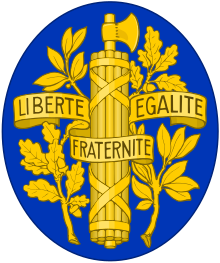1959 French Senate election
The first senatorial elections of the Fifth Republic were held in France on April 26, 1959.[1]
| This article is part of a series on the |
| Politics of France |
|---|
 |
|
|
|
Related topics
|
Context
The Senate was created by constitution of the Fifth Republic to replace Council of the Republic. This election depend largely of the results of 1959 municipal elections.
Results
| Group | Ideology | Seats | Percentage | |
|---|---|---|---|---|
| Independent Republicans (RI) | Liberalism, Right-wing | 70 | 22,6 % | |
| Democratic Left (GD) | Radicalism, Right-wing, Left-wing | 66 | 21,3% | |
| Socialist (SOC) | Socialism, Left-wing | 61 | 19,7% | |
| Union for the New Republic (UNR) | Gaullism, Right-wing | 37 | 12,0% | |
| Popular Republican Movement (MRP) | Christian democracy, Right-wing | 34 | 11,0% | |
| Republican Centre of Rural and Social Action (CNIP) | Conservatism, Right-wing | 20 | 6,5% | |
| Communist (COM) | Communism, Left-wing | 14 | 4,5% | |
| Non-Registered (NI) | None | 7 | 2,3% | |
| Total: | 309 | 100,0 % | ||
Senate Presidency
On April 28, 1959, Gaston Monnerville a senator from Guyane was elected president of the Senate. Monnerville has been the highest-ranking black politician in French history, and if he was a candidate for reelection in 1968, he could have become the first black president of France the next year when President Pompidou dies.[2]
List of senators elected by region
| Senator | Group | District | Source | |
|---|---|---|---|---|
| Louis Jung | RP | Bas-Rhin | ||
| Michel Kauffmann | RP | Bas-Rhin | ||
| Michel Kistler | RP | Bas-Rhin | ||
| Paul Wach | RP | Bas-Rhin | ||
| Paul-Jacques Kalb | UNR | Haut-Rhin | ||
| Eugène Ritzenthaler | UNR | Haut-Rhin | ||
| Modeste Zussy | UNR | Haut-Rhin | ||
| Marcel Brégégère | SOC | Dordogne | ||
| Charles Sinsout[3] | GD | Dordogne | ||
| Marc Pauzet | CNIP | Gironde | ||
| Georges Portmann | RI | Gironde | ||
| Max Monichon | CNIP | Gironde | ||
| Raymond Brun | CNIP | Gironde | ||
| Jean-Louis Fournier | SOC | Landes | ||
| Gérard Minvielle | SOC | Landes | ||
| Jacques Bordeneuve | GD | Lot-et-Garonne | ||
| Étienne Restat | GD | Lot-et-Garonne | ||
| Guy Petit | RI | Basses-Pyrénées | ||
| Jean Errecart | RP | Basses-Pyrénées | ||
| Jean-Louis Tinaud | RI | Basses-Pyrénées | ||
| Fernand Auberger | SOC | Allier | ||
| Georges Rougeron | SOC | Allier | ||
| Hector Peschaud | CNIP | Cantal | ||
| Paul Piales | CNIP | Cantal | ||
| Robert Bouvard | RI | Haute-Loire | ||
| Jean De Lachomette | CNIP | Haute-Loire | ||
| Michel Champleboux | SOC | Puy-de-Dôme | ||
| Francis Dassaud | SOC | Puy-de-Dôme | ||
| Gabriel Montpied | SOC | Puy-de-Dôme | ||
| Louis Andre | RI | Calvados | ||
| Jacques Descours-Desacres | RI | Calvados | ||
| Jean-Marie Louvel | RP | Calvados | ||
| Henri Cornat | RI | Manche | ||
| Léon Jozeau-Marigne | RI | Manche | ||
| Michel Yver | RI | Manche | ||
| Étienne Le Sassier-Boisauné | RI | Orne | ||
| Paul Pelleray | RI | Orne | ||
| Roger Duchet | RI | Côte-d'Or | ||
| Étienne Viallanes | RI | Côte-d'Or | ||
| François Mitterrand | GD | Nièvre | ||
| Jacques Gadoin | GD | Nièvre | ||
| Roger Lagrange | SOC | Saône-et-Loire | ||
| Marcel Legros | RI | Saône-et-Loire | ||
| Jules Pinsard | GD | Saône-et-Loire | ||
| Philippe de Raincourt[4] | RI | Yonne | ||
| André Plait | RI | Yonne | ||
| André Cornu | GD | Côtes du Nord | ||
| Jean de Bagneux | RI | Côtes du Nord | ||
| Bernard Lemarié | RP | Côtes du Nord | ||
| Jean Fichoux | RI | Finistère | ||
| Yves Hamon | RP | Finistère | ||
| André Monteil | RP | Finistère | ||
| André Colin | RP | Finistère | ||
| Roger du Halgouët | UNR | Ille-et-Vilaine | ||
| Yves Estève | UNR | Ille-et-Vilaine | ||
| Jean Noury | RP | Ille-et-Vilaine | ||
| Marcel Lambert | RI | Morbihan | ||
| Victor Golvan | UNR | Morbihan | ||
| Joseph Yvon | RP | Morbihan | ||
| Jean-Paul de Rocca-Serra | GD | Corsica | ||
| Jacques Faggianelli | GD | Corsica | ||
| Marcel Boulangé | SOC | Territoire de Belfort | ||
| Jacques Henriet | RI | Doubs | ||
| Marcel Prélot | UNR | Doubs | ||
| Edgar Faure | GD | Jura | ||
| Charles Laurent-Thouverey | GD | Jura | ||
| Henri Pretre | RI | Haute-Saône | ||
| André Maroselli | GD | Haute-Saône | ||
gollark: The obvious solution is piracy™.
gollark: I can't actually be bothered, myself.
gollark: Only for the US though, and I think this is using an outdated architecture.
gollark: https://nirvan66.github.io/geoguessr.html
gollark: I checked and they have.
References
- Élections sénatoriales 1959
- On a failli avoir un président noir en France...
- election annulled by the Constitutional Council
- dies two months later and was replaced by Paul Guillaumot
This article is issued from Wikipedia. The text is licensed under Creative Commons - Attribution - Sharealike. Additional terms may apply for the media files.